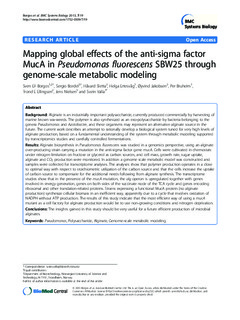Mapping global effects of the anti-sigma factor MucA in Pseudomonas fluorescens SBW25 through genome-scale metabolic modeling
Borgos, Sven Even F.; Bordel, Sergio; Sletta, Håvard; Ertesvåg, Helga; Jakobsen, Øyvind Mejdell; Bruheim, Per; Ellingsen, Trond Erling; Nielsen, Jens; Valla, Svein
Journal article, Peer reviewed
Permanent lenke
http://hdl.handle.net/11250/2358401Utgivelsesdato
2013Metadata
Vis full innførselSamlinger
Sammendrag
Background: Alginate is an industrially important polysaccharide, currently produced commercially by harvesting of
marine brown sea-weeds. The polymer is also synthesized as an exo-polysaccharide by bacteria belonging to the
genera Pseudomonas and Azotobacter, and these organisms may represent an alternative alginate source in the
future. The current work describes an attempt to rationally develop a biological system tuned for very high levels of
alginate production, based on a fundamental understanding of the system through metabolic modeling supported
by transcriptomics studies and carefully controlled fermentations.
Results: Alginate biosynthesis in Pseudomonas fluorescens was studied in a genomics perspective, using an alginate
over-producing strain carrying a mutation in the anti-sigma factor gene mucA. Cells were cultivated in chemostats
under nitrogen limitation on fructose or glycerol as carbon sources, and cell mass, growth rate, sugar uptake,
alginate and CO2 production were monitored. In addition a genome scale metabolic model was constructed and
samples were collected for transcriptome analyses. The analyses show that polymer production operates in a close
to optimal way with respect to stoichiometric utilization of the carbon source and that the cells increase the uptake
of carbon source to compensate for the additional needs following from alginate synthesis. The transcriptome
studies show that in the presence of the mucA mutation, the alg operon is upregulated together with genes
involved in energy generation, genes on both sides of the succinate node of the TCA cycle and genes encoding
ribosomal and other translation-related proteins. Strains expressing a functional MucA protein (no alginate
production) synthesize cellular biomass in an inefficient way, apparently due to a cycle that involves oxidation of
NADPH without ATP production. The results of this study indicate that the most efficient way of using a mucA
mutant as a cell factory for alginate production would be to use non-growing conditions and nitrogen deprivation.
Conclusions: The insights gained in this study should be very useful for a future efficient production of microbial
alginates.
